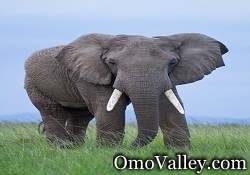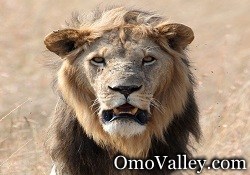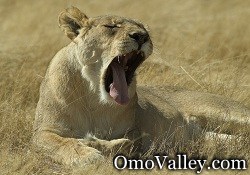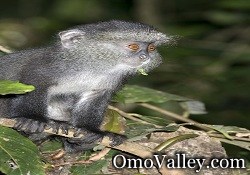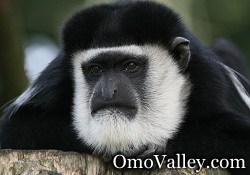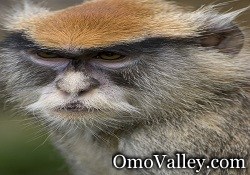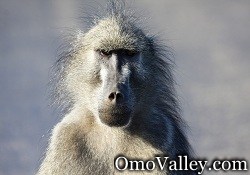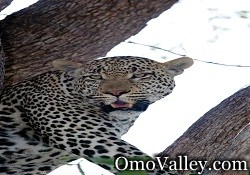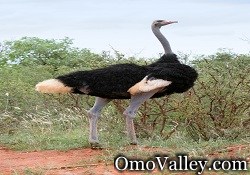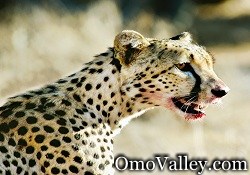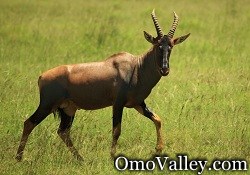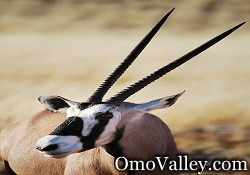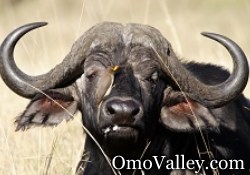
African or Cape Buffalo
There are two species of rhinos in Africa. The white or squared lipped rhino lives in the savannas enjoying water and mud holes. It is the larger of the two weighing between 7,000 and 10,000 pounds. It stands approximately 6 feet and is between 11 to 15 foot long. They have a flat square mouth. The black rhino can vary between habitats, but mainly likes dense wooded vegetation. It weighs between 2,000 and 3,500 pounds. They are between 11 and 13 ft. in length and stand about 5 feet tall. It has a pointed mouth and is much smaller then the white rhino. Both rhinoceros are herbivores. The white rhino enjoys grazing while the black rhino prefers leafs and twigs. They have very few predators, but fall victim to poachers.
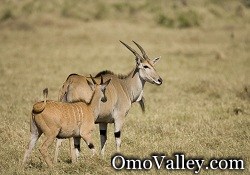
Eland
The Eland is the world's largest antelope. It stands about 5 to 6 feet tall and can weigh around 1500 lbs. Even at it's size, they can jump up to 8 feet from a standstill position. Their horns can grow up to 4 feet long. Like the buffalo, they are herbivores and prefer to eat leaves, fruits and roots. They travel in herds and their main predator are humans. Humans have attempted to domesticate the Elands due to their tender meat and high protein content in the milk they produce.
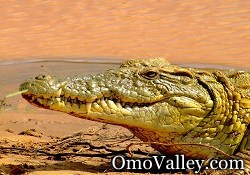
Nile Crocodile
Measuring between 11 and 16 feet long and weighing 500 to 700 lbs, it is the largest crocodilian in Africa. Crocodiles are carnivores and often prey on waterbuck, wildebeest, zebra, goats and cattle. Although its rare, crocodiles will try to capture much larger prey like the buffalo, hippo or rhinoceros. When not hunting mammals, they will eat fish. Human hunters are the crocodiles only predator. The Nile crocodile will attack a human and is said to kill several hundred people a year.
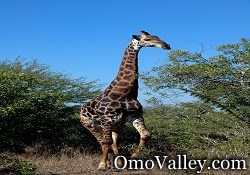
Giraffe
Giraffes are the tallest land living animals. Their weight can range from 1,800 lbs to 4,000 lbs and can reach heights up to 20 feet. Giraffes are herbivores and are found in the savannas, grasslands or woodlands. Their diet consist of twigs, grass, and fruit. They consume large amounts of water if available and can sustain dry arid areas. The only major predator that threatens the giraffe are lions. Their defense is a strong kick that can kill its attacker.
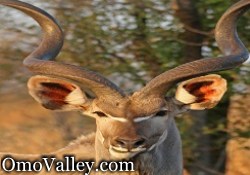
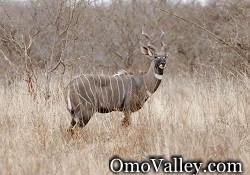
Kudu
There are two types of kudu that can be found in the lower Omo Valley. The greater and lesser kudu are both cousins. The greater kudu is a woodland and brush land antelope. The males are much larger then the females and have large horns that twist. Their horns can reach up to 3 feet in length. A male greater kudu can weigh between 400 and 600 lbs, while the females weigh between 250 and 450 lbs. The lesser kudu is a forest and thicket antelope. They are much smaller then the greater kudu. The males weigh between 150 to 220 lbs and the females weighing in at 120 to 150 lbs. The male lesser kudu's horns reach about 2 feet in length. Both species are herbivores and their diet consists of leaves and plants. They are both hunted by lions, leopards, cheetahs and humans.
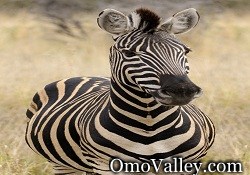
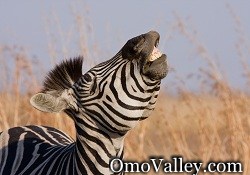
Zebra
The Burchells zebra is also known as the plains or common zebra. It can be found in the savannas, woodlands or grasslands. They are herbivores and graze on different grasses as well as certain shoots. Both the male and female stand about 4 1/2 feet tall and are about 8 feet long. They can weigh between 400 and 700 lbs. The zebras main predators are lions, hyenas and the Nile crocodile. Zebras are best known for their unique black and white stripes.
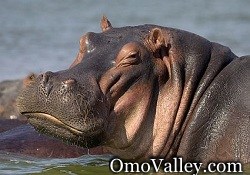
Hippopotamus
Also known as the hippo, it is the third largest land animal. They are estimated to weigh between 3,000 and 7,000 lbs. The hippo stands about 5 feet tall and can reach lengths up to 17 feet. It can live in water or on land and is able to walk on the bottom of rivers. The water and mud from the river keeps the hippo's body cool. Even with it's massive size, they are able to run up to 30 mph for short distances. They are known to be very aggressive towards humans and Nile crocodiles. Some say the hippo is one of the most dangerous animals in Africa. They are herbivores and graze on grass. Their only predators are humans, but crocodiles have been known to attack their young.
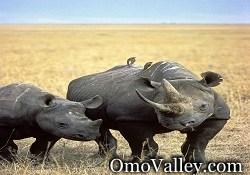
Rhinoceros
There are two species of rhinos in Africa. The white or squared lipped rhino lives in the savannas enjoying water and mud holes. It is the larger of the two weighing between 7,000 and 10,000 pounds. It stands approximately 6 feet and is between 11 to 15 foot long. They have a flat square mouth. The black rhino can vary between habitats, but mainly likes dense wooded vegetation. It weighs between 2,000 and 3,500 pounds. They are between 11 and 13 ft. in length and stand about 5 feet tall. It has a pointed mouth and is much smaller then the white rhino. Both rhinoceros are herbivores. The white rhino enjoys grazing while the black rhino prefers leafs and twigs. They have very few predators, but fall victim to poachers.
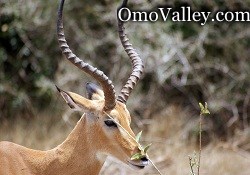
Gazelle
The Thomson's Gazelle is the most common in Africa. They are found in open plains and grassland areas. It stands 2 to 3 feet tall and weighs between 30 and 100 pounds. They travel in herds and can reach speeds up to 40 mph. The gazelle is a herbivore and eats mostly grasses. It is preyed upon by cheetahs, lions, leopards, crocodiles and hyenas.
